
Latest News.
Leaders League honors Kather Augenstein in two categories in latest 2022 ranking
The international French media and rating agency Leaders League, which has been evaluating professional service firms for more than 20 years, has published its ranking for Best Law Firms – 2022 in Germany.
Kather Augenstein was again awarded one of the “Best Law Firms” in the categories “Trademark Litigation” and “Patent Litigation” this year. In the field of Trademark Litigation, the two partners Dr Christof Augenstein and Sören Dahm were recommended for their expertise. In the field of Patent Litigation, the partners Dr Peter Kather, Dr Christof Augenstein, Christopher Weber and Managing Partner Miriam Kiefer LL.M. were highlighted as excellent for their work in the current ranking.
The media group publishes international rankings and news content for the legal, financial, technology and human resources sectors. The company is specialised in producing rankings and market research, which are used by a large number of companies and executives in their decisions. All the rankings are available free of charge at www.leadersleague.com
Congratulations for this special award!
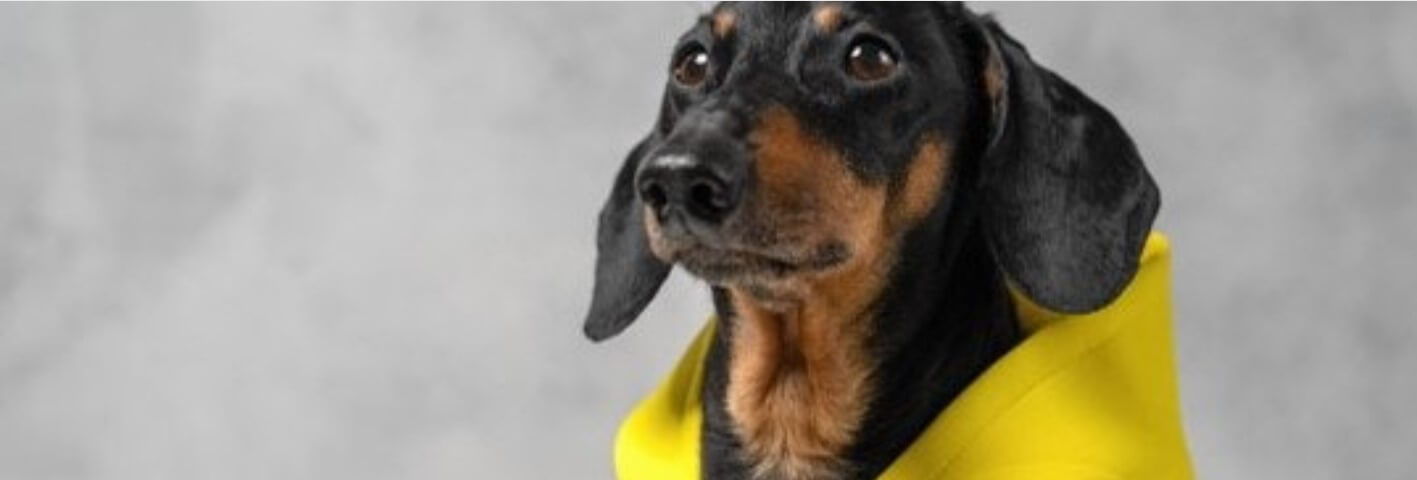
Latest News.
„The North Face“ „The North Face“ vs. „The Dog Face“
Can dog owners who do sports and wear “The North Face” now do their outdoor sports in a partner look with their pet? At least that’s what you might think when dog clothing is advertised with the name “The Dog Face”. The name sounds familiar, because it is associated with the outdoor and lifestyle brand “The North Face” – at least that’s how the well-known clothing manufacturer saw it and went to court.
It is becoming increasingly common for small companies to use the familiarity of major brands to advertise their own products. The exploitation of well-known trademarks or catchy design language creates a familiar feeling among customers and influences their buying behavior. The exploited appreciation gives less established companies a better market position, much to the annoyance of the established brands. After all, a brand’s products are creative services that determine the company’s value. To ensure that companies remain the sole users of their innovative services, they must protect their intellectual property. Trademark law serves to protect against the exploitation of a company’s own reputation. A trademark is protected if it is registered. According to the German Trademark Act, registration can take place at the German Patent Office, or at the EU level – at the Office for Harmonization in the Internal Market. Once the trademark has been registered, the following principle applies: competitors may no longer advertise their products under this brand name. If they do so, they may be entitled to injunctive relief or monetary compensation. It is important to note that not only brand names can be registered. Combinations of words and images or simple figurative representations such as the “Nike Swoosh” can also be protected under trademark law. This is also the case with “The North Face”, whose brand name and logo are protected under trademark law.
In the case in question, the OLG Frankfurt has now ruled by order that animal clothing may not be marketed with “The Dog Face”. Initially, the Frankfurt Regional Court had decided otherwise and dismissed the injunction claims asserted by “The North Face” in an urgent proceeding. On appeal, the Frankfurt Higher Regional Court amended this decision to the effect that the pet clothing company must now refrain from using the brand name and the well-known logo. According to the court, there is a similarity between “The Dog Face” and “The North Face”, which is causing damage to “The North Face” and exploiting its reputation in a “parasitic manner”.
In support of its decision, the court states that “The North Face” is a well-known mark within the meaning of the EU Trade Mark Regulation [Regulation (EU) 2017/1001]. It is known to a significant part of the public.
It is true that there is no likelihood of confusion between the names “The North Face” and the name “The Dog Face” used by the animal clothing manufacturer. This is because the words “Dog” and “North” are recognizably different. However, exact copying is not a prerequisite for injunctive relief under Article 9 2 lit. c) of the Regulation. Sufficient is a similarity which causes the relevant public to form a mental link between the two signs. This is the case, according to the Higher Regional Court of Frankfurt. It is true that the words “dog” and “north” are recognizably different for third parties. The similarity lies in the fact that the word sequence “The Dog Face” is clearly recognizable as being based on “The North Face”. Due to the high degree of recognition of the trademark and the fact that there is a certain similarity between the goods offered, the court assumes that the two companies are mentally linked to each other.
The animal clothing company is now no longer allowed to profit from this link. But perhaps The North Face will soon launch its own animal clothing line. Then sports enthusiasts will indeed soon be able to dress as partners with their dogs.
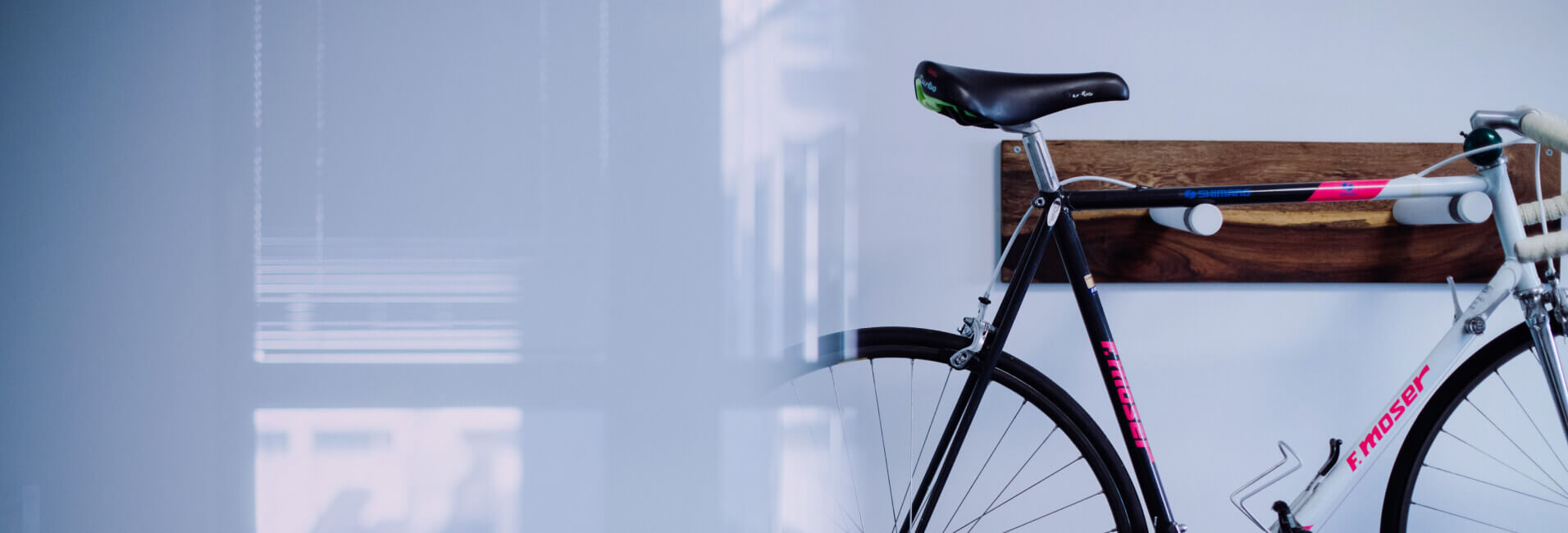
Latest News.
LEL 2022: Christoper Weber on his 1500km long distance cycle ride from London > Edinburgh > to London in less than 120 hours
This year’s LEL 2022 edition took place from 7 to 12 August. LEL is a 1500 km long race across the United Kingdom between the famous capitals of England and Scotland. LEL is not a cycling race of the classic kind with support vehicles on closed-off tracks, it is an audax event (endurance challenge) for self-supported cyclists, who use it to demonstrate not only their physical and mental endurance, but also their independence within a tight time limit.
Besides the impressive Trailer of the organizers, we interviewed our partner Christopher Weber about how he fared on his tour.
Photos: Cheerful before the start – Already back to England in the dark of night
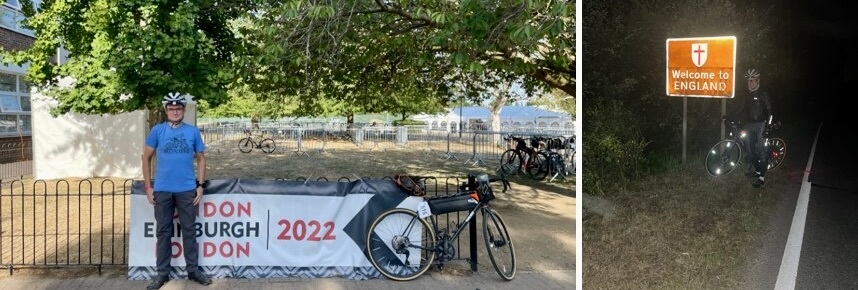
CHRISTOPHER, WHAT INSPIRED YOU TO PARTICIPATE IN LEL 2022 AND HOW DO YOU MANAGE TO BALANCE YOUR TRAINING TIME WITH FAMILY, JOB AND POSSIBLY OTHER HOBBIES TO GET PREPARED FOR SUCH A SPORTING EVENT?
LEL is certainly one of the most famous ultra long distance events and therefore attracts riders from all over the world. I have met Argentines and Australians, Latvians and Japanese, Malaysians and US Americans, Italians and Norwegians, Indians and South Africans. The passion for the challenge, for the long distance, for this very specific experience unites the participants, despite all the differences in terms of culture, but also in terms of having a specific cycling experience. It is a different thing for a Malay to ride through the night at 6° C than for a Norwegian. It is different for an Indian to ride through 37° C midday heat compared to a North German. Wind and mountains are also felt differently depending on experience.
At the same time, LEL is organized by an association with the help of volunteers. It is not an event with an all-inclusive carefree package and a corresponding sense of entitlement on the part of the participants, but a friendly, enthusiastic and inspiring event.
I found all of this very attractive. Add to that the fact that 3 years ago, when I signed up, I was reasonably in shape and a bit overconfident. Well what has happened since then, we all know only too good unfortunately. And last but not least, it was not conducive to my sporting form, so I went with some fear of my own courage to the start. Because more “training” than commuting to the office or sometimes at 6am a quick round or sometimes a “Weekend-Warrior” ride was simply not there for me last year. But accordingly intensely I have done the weekend rides.
Photos: The Wolds – altitude progress – English high moors
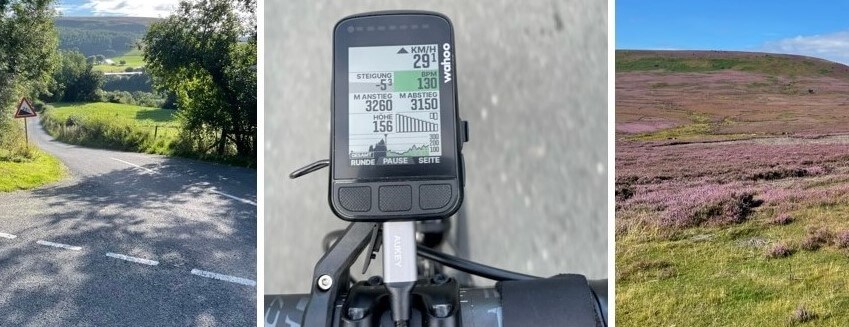
HOW DID YOU REACH ENGLAND WITH YOUR EQUIPMENT AND HOW DID YOUR START WENT ?
On Friday I went to England with the car, the ferry and my bikes. Registration and last test drive on Saturday, check the equipment and the bags three times and repack and then I put my legs up properly and strengthened myself with fast food 
Because you have to be able to help yourself at any time on the course, a fair amount of brain power went into the equipment. For example, I had tools, spare parts, spare rear lights, a self-soldered charging station for the dynamo, a rescue bivy sack, sports headphones and about 45 other things with me.
Photos: 48h/ 750km – Hi there! – Sprint through a village
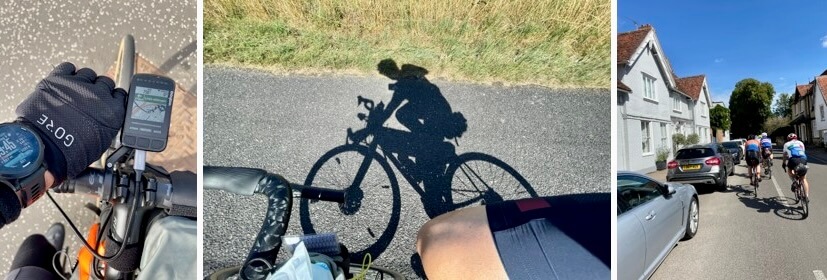
1500 KM IS A LONG DISTANCE. HOW DID YOU FEEL ON THE TOUR AND HOW DID YOU MANAGE THE INDIVIDUAL STAGES?
I wanted to gain a nice time pad at the beginning to take the pressure out of the time limit. So I managed 360 km in the first stage and after a short sleep a good 420 km in the first 24 hours. From there it became very, very hilly, it went through high moors, The Wolds and through the Northern Pennines, a low mountain range, and then already to Scotland, in the so-called Lowlands. But I didn’t found them that low. After another 2 hours sleep and a total of 48 hours, the iconic bridges over the Firth of Forth behind Edinburgh were already in my sight!
Behind Edinburgh was the turning point. From there the route led through the middle of the beautiful but very busy Edinburgh back into the mountains and back to England, where I then reached a checkpoint again on Wednesday morning around 3am. Unfortunately, it was overcrowded, so that I only had a sleeping place outside. Sweating and at a few degrees and two blankets weren’t enough, so I got up a bit undercooled and after 2 hours I was on my way again. After 3 hours in the first night and 2 hours in the second night that was a bit little sleep and I had to rest several times next to the trail on some meadow. In the area also fell probably the most strenuous stages of the tour, there were steep climbs through the Northern Pennines and then also through the Howardian Hills to cope. Pushing would have been smarter, but you are a cyclist …
Anyway, by then I had experienced a very comfortable time cushion and I could switch to the mode “enjoy”. From then on, I ate as much as I could at absolutely every route control, so mostly two main dishes and dessert. Every 200 km or so, I also took an anti-cyclical nap for about 2 hours, so I wasn’t disturbed by snorers. So I made good and steady progress and the time limit was never really in danger. But then the usual long-distance aches and pains came up. Sure, the seating area and the hands and sometimes the feet, or the knees, or a shoulder or the stomach. There is always something. But the hands have properly got something damage on the Scottish humps. It was very difficult to change the tire at the first puncture and not easier at the second puncture. But apart from that, I was spared any technical difficulties.
I am attracted by the electronic gearshift, without which the hands would have had even more to do. In addition, the battery is still more than half full after more than 1,500 km. And was switched on the route with over 14,500 meters of altitude, of course, quite neat.
Towards the end of the tour there was some real, real fun again, both through the area of The Fens (a flat, windy area with meadows, canals and windmills), and through the area around Cambridge and towards the finish it was either flat or just undulating enough to be challenging, but without any more double-digit climbs. And finally with another luxurious 3,5 hours sleep, I then tackled the last 110 km on the last morning at a nice average speed. On the last 50 km you are anyway carried by the euphoria and so I arrived with a big grin and sprinting at the finish.
Photo: All controls stamped!

LEL 2022 IS CERTAINLY A GREAT TEST FOR MENTAL AND PHYSICAL RESILIENCE, USING SKILLS AND EXPERIENCE. ALL RESPECT AND CONGRATULATIONS CHRISTOPHER, YOU MADE IT! WHAT WAS GOING THROUGH YOUR MIND AT THE FINISH LINE AND HAVE YOU RECOVERED FROM THE EXERTIONS IN THE MEANTIME?
Before the strt I didn’t expect to be able to finish. There are simply too many things that can go wrong on such a long ride that you can’t control yourself. It was also questionable how I would cope with the lack of sleep. And my longest ride before wasn’t even a third as long. And after all, only half of the participants make it to the finish line within the time limit, and they are no beginners at all …
But the doubts were all blown away once the ride started. From then on, I didn’t doubt for a second that I would make it. I believed so strongly in success with everything I had that it felt like certain knowledge. So even with the lack of sleep and the effort, I never got into mental trouble, never looked up train connections or dithered, but always just thought about the next step. I think this subjective component made it objectively easier for me in the end. And physically, you can say it in the immortal words of legend Jens Voigt: “Shut up, legs!” Except that at some point that was no longer enough, but a few more body parts had to be enumerated.
Photo: Christopher Weber after 119 hours, 1,540 km, 14,500 altitude meters and 30 min. after crossing the finish line. (Photo credit Charlotte Barnes, https://www.charlottebarnes.co.uk/lel2022hardriders)
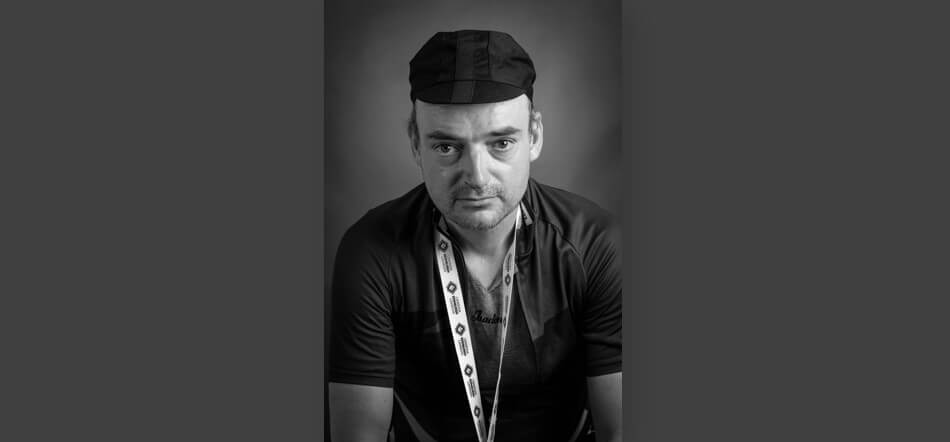
At the finish line, I wasn’t proud or relieved or anything else that you could be put into words so specifically. I was just unbelievably happy. Any pride would also be opposed to the fact that LEL as a challenge teaches you a fair amount of humility. I recovered amazingly fast. Basically, I caught up on sleep.
I couldn’t have made it without the many cheering and funny messages of family, friends and colleagues from home and the kindness of strangers, whether by helping me to change a tyre or just having a nice chat during a night that dragged on like chewing gum. There were many absolutely fascinating sights and things that happened, both in nature and in purely human terms. I will definitely think back on this experience for a very long time.
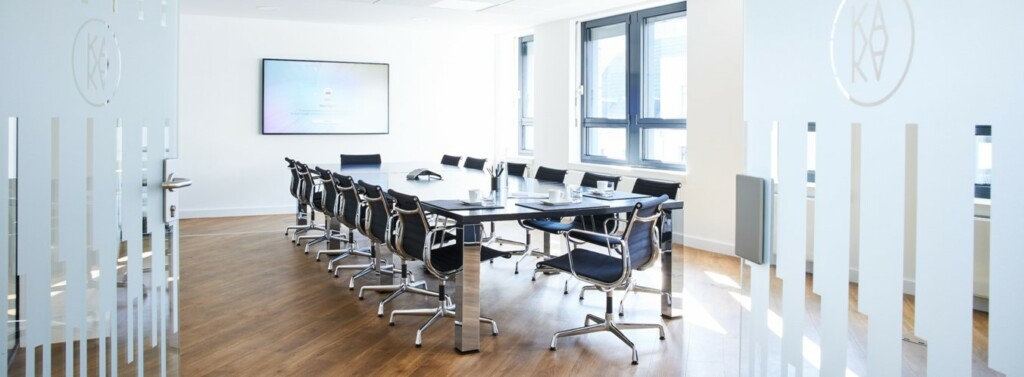
Latest News.
Preparing the Unitary Patent System: Miriam Kiefer LL.M. holds the opening lecture for an online seminar series organized by the Japan External Trade Organization (JETRO)
After lengthy discussion, the Unitary Patent (UP) and Unified Patent Court (UPC) are finally expected to start in the first half of next year. At invitation of the Japan External Trade Organization (JETRO), Miriam Kiefer LL.M. held the opening lecture on the Unified Patent Court proceedings. The seminar series has generated a great interest among Japanese companies, with around 170 participants attending.
The three scheduled lectures focus on the procedural aspects of the proceedings before the Unified Patent Court and are primarily aimed at japanese patentees to consider their future filing and litigation strategies.
In her presentation, Miriam Kiefer LL.M. specifically addressed the general structure of the UPC and the usal course of the proceedings, including substantive law in the UPC Agreement and the language regime. She concluded her presentation with thoughts on the pros and cons of the opt-out. Numerous questions from the audience confirmed the great interest.
The seminar series will continue in September with Dr. Christof Augenstein.
The second lecture will focus on the general procedural rules as well as on the details of the proceedings, including but not limited of the importance of the interim proceedings. Finally, the third lecture in October will focus on special types of proceedings, as for example judgment by default, preliminary injunction proceedings and isolated nullity revocation actions, and will be concluded with comments on the costs of the proceedings.
All lectures will be held and recorded in English. Simultaneous translation into Japanese will also be available for participants.
PROGRAM OVERVIEW:
Tuesday, 20 September, 2022 – From the Statement of Defence to the Interlocutory Proceedings to the Oral Hearing
Speaker: Dr. Christof Augenstein
Language: English (simultaneous translation into Japanese)
Time: 9:00-11:00 (BST)/ 10:00-12:00 (CET)/ 17:00-19:00 (ST), via ZOOM
Tuesday, 4 October, 2022 – Special Types of Proceedings and Costs of Proceedings
Speaker: Dr. Christof Augenstein
Language: English (simultaneous translation into Japanese)
Time: 9:00-11:00 (BST)/ 10:00-12:00 (CET)/ 17:00-19:00 (ST), via ZOOM
Earlier in June, Miriam Kiefer LL.M. gave a preparatory overview of patent law reform in Germany in a 90-minute presentation.. “In the subsequent discussion on the development of case law at the instance courts, the importance of the reform for companies was reflected and discussed with the participants,” said Miriam Kiefer.
JETRO (Japan External Trade Organization), was established in 1958 by the Japanese Ministry of International Trade and Industry (MITI) to support and promote Japanese export efforts. In the 21st century, JETRO’s focus has shifted to promoting foreign direct investment in Japan and helping small to medium-sized Japanese companies maximize their global export potential. JETRO has 76 overseas offices in 55 countries worldwide and 48 offices in Japan, including headquarters in Tokyo and Osaka. In Germany, JETRO has three offices in Berlin, Düsseldorf and Munich.

Latest News.
The Pharmaceutical Intellectual Property and Competition Law Review: Christopher Weber and Dr Benjamin Pesch publish on recent developments of Intellectual Property and Competition Law in the pharmaceutical sector in Germany
The Pharmaceutical Intellectual Property and Competition Law Review is an annual hardcover and online guide covering legal and market developments in key jurisdictions in the pharmaceutical sector worldwide. As an “annual review”, the publication provides a detailed analysis of recent developments in legislation and its interpretation by national authorities around the world and aims to give users an insight into future trends.
It serves as a useful tool for managing global risks in this field and analyses the key elements of the relevant legal and regulatory frameworks in the major jurisdictions worldwide. With 11 chapters in total, the publication covers a wide range of important european and international jurisdictions. In Chapter 4 our partner Christopher Weber and our counsel Dr Benjamin Pesch highlight current developments in the german market based on their expertise in the pharmaceutical sector.
“The pharmaceutical sector is one of the most global industries, with many companies operating in dozens of countries with different legal jurisdictions and healthcare systems. In the field of patent law, there are several remarkable developments. On the one hand, there is the reform of Injunctive Relief Act and, on the other hand, the launch of the UPC is coming up. Therefore, opportunities and risks increase for patents that are part of this new system”, says Christopher Weber.
“We advise and represent our clients especially on this background and are particularly pleased that we can also present perspectives on antitrust and pharmaceutical law here”, adds Dr Benjamin Pesch.
A detailed overview about the German chapter is available here. Excerpts of the publication will also be published as part of our partnership on Lexology. If you are interested in a hardback copy of the publication, please contact our two authors:
weber@katheraugenstein
pesch@katheraugenstein
About The Law Reviews:
The Law Reviews is a network of experts covering over 108 areas of law in more than 130 countries worldwide, aimed at practitioners looking beyond their own borders for strategic solutions in foreign jurisdictions.
Progressive thinkers from the world’s leading law firms analyse global legal issues and their business implications. The Law Reviews is an essential resource for lawyers, in-house counsel, governments and corporate executives.
The editors of The Law Reviews are recognised international industry experts in key practice areas.
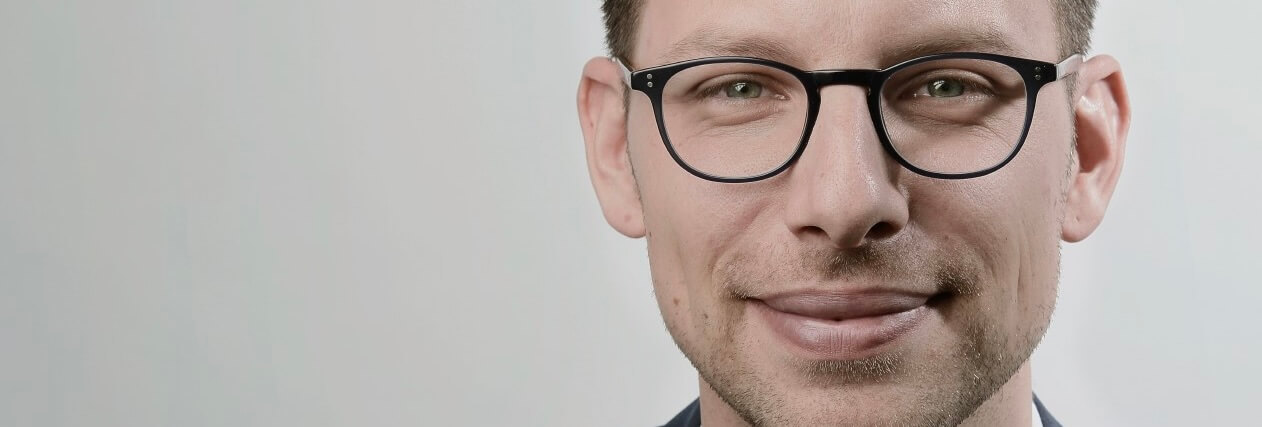
Latest News.
Dr Benjamin Pesch is named Rising Star 2022 again for the second year by Managing Intellectual Property
We are excited to announce that Managing Intellectual Property, one of the most internationally recognised IP publications, has awarded Dr Benjamin Pesch a Rising Star 2022. This is the second year in a row that Dr Benjamin Pesch has received the Rising Star award.
Each year, the IP Stars Rising Stars list highlights outstanding individuals with less than 10 years of professional experience in the field of IP. “Benjamin Pesch has successfully contributed to some of the most challenging and complex mandates in IP at our firm,” said Managing Partner Miriam Kiefer. “To achieve such a recognition again is a great sign that our IP team’s commitment to developing future talent has proven to be successful.”
The Rising Stars publication features more than 600 IP lawyers and over 300 law firms. Managing IP assesses IP practitioners based on independent weighted review of submitted research, market feedback, client and peer interviews, and publicly available information.
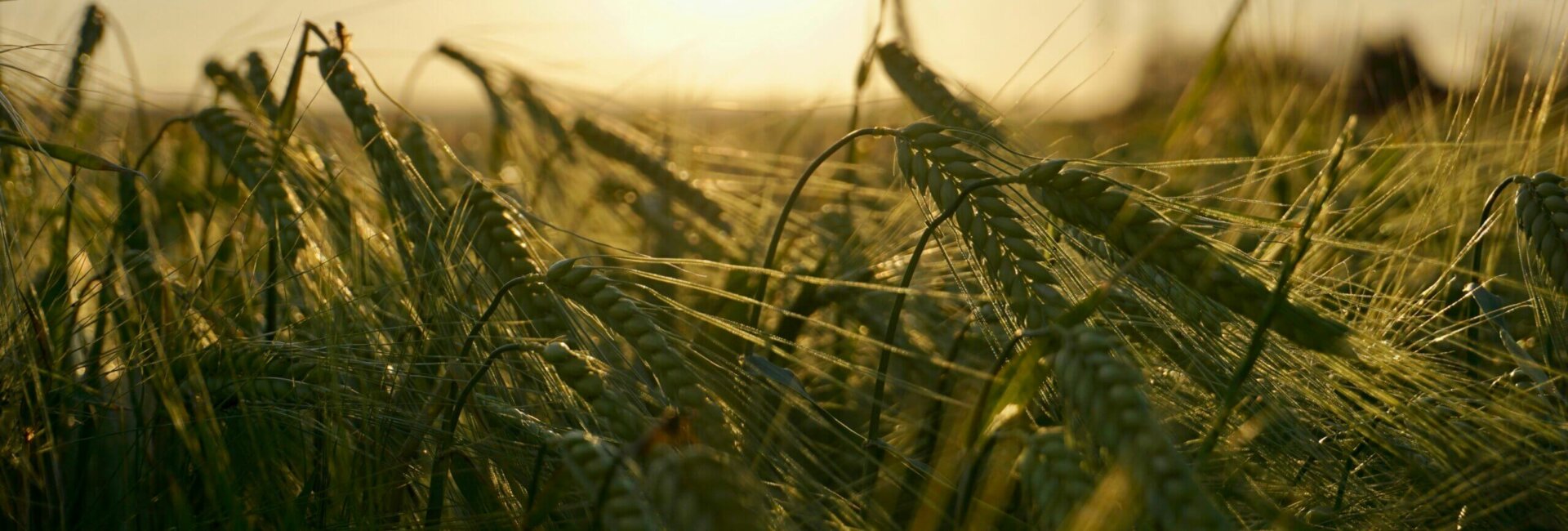
Latest News
Patent on brewing barley: Still no clarity in the granting of bio-patents
Patent for a cool blonde – is that possible? Allocation of bio-patents still not finally clarified. The German’s favourite beverage is beer – or more precisely Pils beer, which celebrates its 180th birthday this year. We take this anniversary and the recent Bavarian October Festival (Oktoberfest) as an opportunity to take a look at the patent law side of the beverage.
So-called bio-patents, i.e. patents in the biotechnological field, are frequently at the centre of socio-political debates. Consumer and environment protection organisations submit complaints against biopatents in the food sector on a regular basis. The main focus is on the question of the patentability of plants from conventional breeding.
Patent protection for mutations?
Article 53 (b) EPC is highly relevant in clarifying this question. According to this article, patent protection for plant varieties or animal breeds as well as biological processes for breeding plants or animals is not possible. Microbiological methods and the products obtained by means of these processes, on the other hand, are patentable. This provision is intended to protect biological diversity.
In practice, this separation made by Art. 53 (b) is far more complex than it appears at first view and leads to the fact, often complained about by critics, that patent protection pushes back traditional breeding and diversity. Because: while the technical steps before or after the cross-breeding or selection process are patentable, every cross-breeding step is an infringement of patentability. As a result, technical selection procedures or product-by-process claims as well as technically induced mutations, which are patentable, are coming into focus.
Malting barley under patent protection.
For example, the big beer companies Heineken and Carlsberg have applied for more than a dozen patents on malting barley mutations. There is resistance to some of them, for example the patent “Beverages made from barley and malt with low dimethyl sulphide content” (EP2373154). An alliance of 35 action partners had filed a complaint against it before the European Patent Office (EPO). According to the complainants, in this patent a genetically random adaptation derived from conventional breeding is considered an invention. It was to be feared that the entire biodiversity of crops would be impaired if patent protection pushed back conventional breeding.
According to the patent description, the invention refers to barley plants that carry a mutation in the gene. This would allow the production of beverages with better taste profiles as well as a significant reduction in the thermal energy input in the beer production process.
EPO decision.
On 8 June 2021, the EPO Technical Board of Appeal rejected the appeal against the patent of Heineken and Carlsberg. In doing so, the Office confirmed the patentability of plants with mutations that influence flavour formation, but failed to clarify the fundamental question of the patentability of plants from conventional breeding.
In recent years, the EPO has repeatedly granted patents on plants that were not produced by genetic engineering but conventionally. In the present case, the natural mutation of the barley variety was triggered by artificially accelerating the mutation rate. That was enough for the Office to grant a patent. That was enough for the Office to grant a patent.
It becomes clear: although European patent laws prohibit claiming conventionally bred plants and animals as inventions, there are numerous loopholes. There is a lack of a clear distinction between accidental mutations and genetic engineering applications.
Criticism and consequences.
In Germany, the previous government of the current federal government made it clear that it did not want patents on conventional breeding. Most of the other states of the 38 contracting nations of the European Patent Office share this view. To enforce this at the patent office, however, a clear political directive is needed, which has not yet been forthcoming.
Unless things change, critics fear a displacement of classical breeding and of the affected farmers, breeders or beer producers will be driven out of business. Small private breweries in particular often do not have the necessary financial resources to apply for their own patents and to pay for the associated legal and court costs that may be required in case of a litigation.

Latest News
Preparing the Unitary Patent System: Dr Christof Augenstein presents follow-up of an online seminar series at the Japan External Trade Organization (JETRO)
Last Tuesday, the third online seminar of a virtual event series took place on the invitation of the Japan External Trade Organization (JETRO).
The total of three consecutive lectures focused on the procedural aspects of the proceedings before the Unified Patent Court and are primarily directed at Japanese companies to define their future application and litigation strategies in Europe.
According to the kick-off seminar by Miriam Kiefer LL.M.in August (we reported in detail in our blog), in which the participants received an overview of the UPC received, the Seminarrseries under the leadership of Dr. Christof Augenstein in September. continued and now in October on the basis of a 3. Modules completed. A total of approx. 400 interested parties took part in the events.
All online presentations were held in English and recorded on video, and simultaneous translation into Japanese was also available to participants.
We would like to take this opportunity to thank you once again for the great interest shown and the professional organization of all three events.
As a follow-up, we are pleased to make the video recordings of the entire lecture series available to you once again in digital form:
1). Seminar vom 30. August 2022:UPC Overview
2). Seminar vom 20. September 2022:UPC Proceedings in Detail
3). Seminar vom 4. Oktober 2022: Special Types of Proceedings and Costs
Die Video-Aufzeichnungen können außerdem auch in Japansicher-Simultanübersetzung abgerufen werden:
1). Seminar vom 30. August 2022: UPC Overview
2). Seminar vom 20. September 2022:UPC Proceedings in Detail
3). Seminar vom 4. Oktober 2022: Special Types of Proceedings and Costs
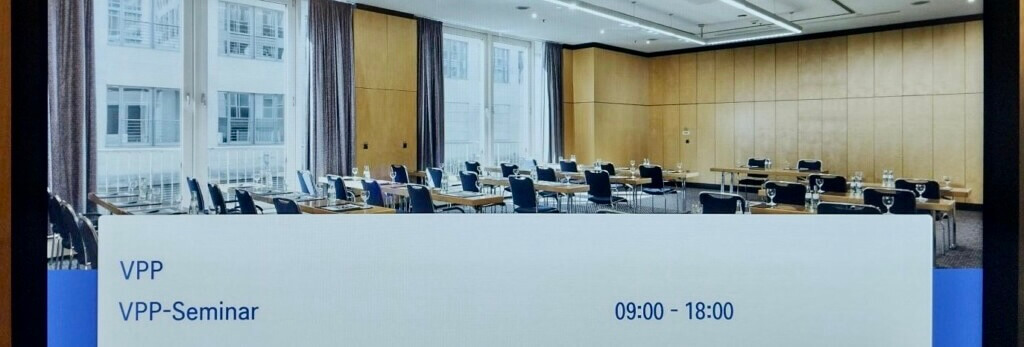
Latest News
VPP-Seminar: Dr Christof Augenstein, Sören Dahm and Miriam Kiefer lecture at VPP seminar “The Infringement Trial”
Last thursday until saturday, a three-day VPP seminar “The Infringement Trial” took place in presence in Berlin. Our partners Dr Christof Augenstein, Sören Dahm and Miriam Kiefer LL.M. lectured in rotation on the details of patent infringement proceedings.
In the seminar, which takes place once a year on this basis, the enforcement of technical IP rights in the practice was covered in detail and intensively discussed with the participants. The lecturers provided detailed knowledge about the process of an infringement case, from notification to warning, to court proceedings including enforcement – in each case from the perspective of the patent owner and the defendant. References to proceedings in front of the Unified Patent Court (UPC) were explained as well.
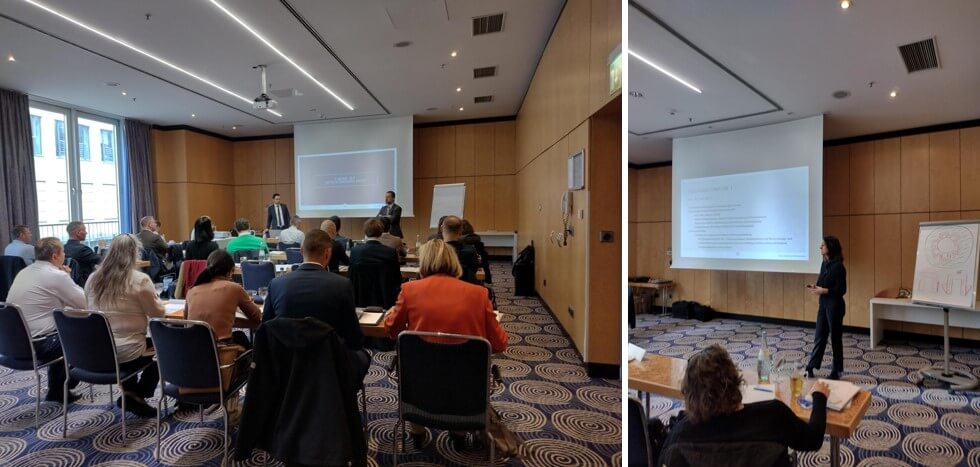
Our thanks goes to the audience for their participation in the VPP seminar, for the interesting input as well as the very valuable exchange around the lectures during these three days.
For those who could not make it in October, it will be on the 3. and November 4, 2022 at the Maritim Hotel in Munich, there will be another two-day event on infringement litigation before the Unified Patent Court (UPC). We would like to point out that this date is already fully booked, but an inclusion in the move-up list is possible. Detailed information and a comprehensive programme overview around the seminar can be found here.
VPP-Seminars 2023:
Due to the huge demand, planning for a continuation of the seminars in 2023 is already underway. As soon as the first date in January is fixed, we will inform you immediately.
Further information and seminar announcements are available on the VPP e.V. website.

Latest News
JUVE Patent Ranking 2022: Kather Augenstein ranks again among the top IP firms and leading IP specialists in Germany
Every year, law firms are subjected to comprehensive evaluations in rankings. We are very pleased that Kather Augenstein was again able to defend its ranking of previous years in the current edition of the highly regarded JUVE Patent Ranking 2022.
Kather Augenstein continues to be awarded four stars in the second highest rating and is listed in the third highest group in the patent litigation/lawyers category.
In addition to the strength for litigation, JUVE Patent in this year’s evaluation particularly emphasizes the European orientation of our boutique firm in the upcoming representation of our clients before the Unified Patent Court. Read the full analysis here. Florian Müller’s (FOSS Patents) perspective on the JUVE ranking is also interesting, read here.
Furthermore, we are again represented in the category Leading Individuals: In addition to our senior partner Dr. Peter Kather, our partner Christopher Weber is again singled out as the leading advisor among Germany’s litigation attorneys in patent law.
A special thanks to our clients and peers, who give special recognition to no less than four of our partners and IP specialists. Dr Peter Kather “really gets to now the technology deeply” underlines a competitor, while Miriam Kiefer is rated as “very competent” and recognised for “her very good case management” by clients. Christopher Weber is valued for his special endurance, “he does not give up until he has found a legally viable solution in the client’s interest”, says a fellow competitor. In Christof Augenstein’s case, his “international view of interaction between of European patent court proceedings” is particularly in focus.
“The excellent rating of our firm is never the result of a single person, it is the result of our entire team. The current JUVE Patent Ranking 2022 is based on feedback of our clients and peers, which we are very proud of. We see this as a further incentive to face the challenge of the Unified Patent Court as a highly specialised boutique law firm and thank the experts for their recommendations”, says our Managing Partner Miriam Kiefer.
